When choosing paint for your home office, you'll want to focus on low-VOC or zero-VOC options for the greenest results. These paints emit fewer harmful chemicals, improving your indoor air quality. Natural and organic paints, like clay-based or milk paint, offer non-toxic alternatives with excellent breathability. Recycled paints are another eco-friendly choice, repurposing leftover paint to reduce waste. Look for certifications like Green Seal or GREENGUARD to guarantee you're getting a truly green product. By opting for these environmentally conscious paints, you'll create a healthier workspace while minimizing your environmental impact. Discover how these green options can transform your home office into an eco-friendly haven.
Understanding Green Paint Certifications
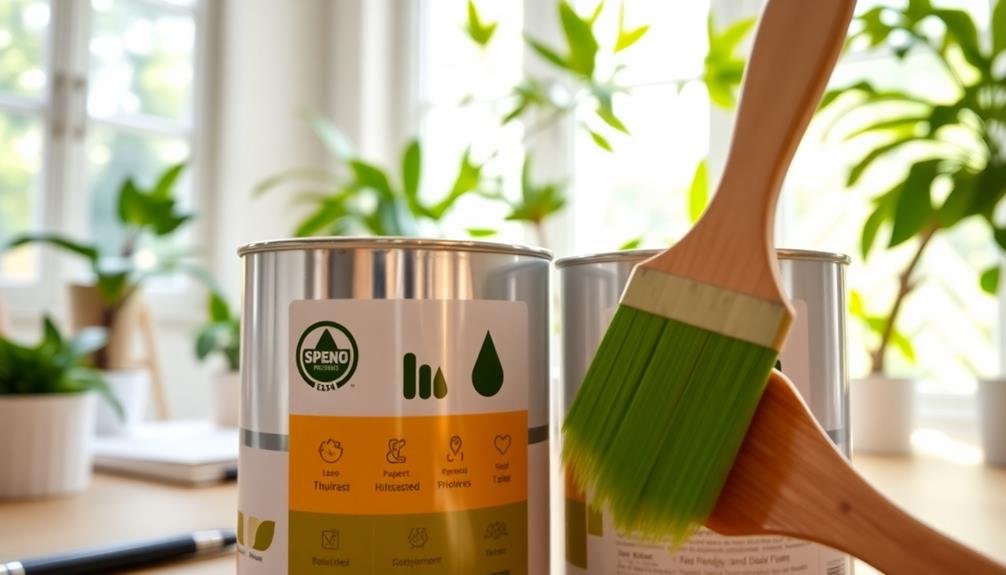
When choosing paint for your home office, understanding green paint certifications is essential. These certifications help you identify products that meet specific environmental and health standards. The most recognized certifications include Green Seal, GREENGUARD, and MPI Green Performance.
Green Seal certification guarantees paints have low VOC content, are free from harmful chemicals, and meet performance requirements. GREENGUARD focuses on indoor air quality, certifying paints that emit low levels of pollutants. MPI Green Performance rates paints based on environmental impact and performance criteria.
Look for labels like "zero VOC" or "low VOC," but be aware that these claims aren't always regulated. Some manufacturers may use their own eco-friendly labels, which can be misleading. To ascertain you're choosing a truly green paint, cross-reference these claims with third-party certifications.
Consider other factors like recyclable packaging, sustainable manufacturing processes, and the company's overall environmental commitment.
Low-VOC and Zero-VOC Options
The paint aisle can be overwhelming, but understanding VOC levels simplifies your choices. VOCs, or volatile organic compounds, are harmful chemicals that off-gas from paint, affecting indoor air quality and your health. Low-VOC paints contain less than 50 grams per liter, while zero-VOC options have less than 5 grams per liter.
When selecting low-VOC or zero-VOC paints for your home office, consider these options:
- Water-based acrylic paints with minimal VOCs
- Natural clay paints made from earth pigments
- Milk paints derived from milk protein and lime
- Plant-based paints using vegetable oils and resins
- Mineral-based paints with silicate binders
These eco-friendly alternatives offer excellent coverage and durability without compromising your health or the environment.
They're ideal for sensitive individuals, children's rooms, and spaces with poor ventilation. Many major paint brands now offer low-VOC lines, making it easier to find options that match your color preferences and budget.
Natural and Organic Paint Choices
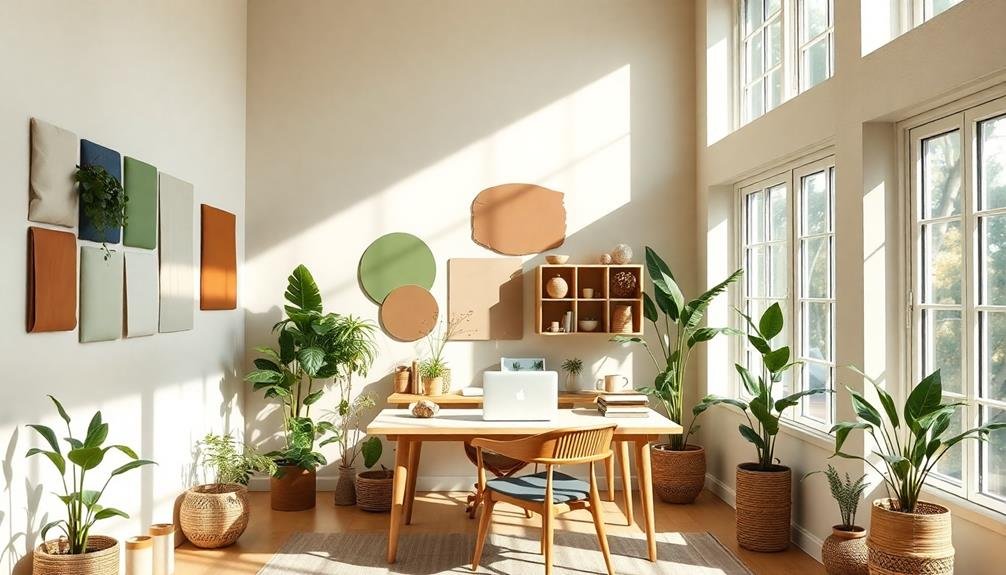
When considering natural paint options for your home office, you'll find clay-based paints to be an excellent eco-friendly choice.
These paints are non-toxic, emit no harmful fumes, and provide a unique, earthy texture to your walls.
If you're looking for a traditional yet sustainable option, milk paint offers durability, a matte finish, and is completely biodegradable.
Clay-Based Paint Options
Among the most eco-friendly paint options available, clay-based paints stand out for their natural composition and organic properties. These paints are made from clay, chalk, and natural pigments, offering a non-toxic alternative to conventional paints.
They're free from volatile organic compounds (VOCs) and synthetic chemicals, making them ideal for your home office environment.
Clay-based paints provide excellent breathability, allowing moisture to pass through walls and reducing the risk of mold growth. They're particularly well-suited for older buildings or homes with damp issues.
You'll find that these paints come in a variety of earthy tones and can create a warm, inviting atmosphere in your workspace.
When considering clay-based paints, keep these visual elements in mind:
- Soft, matte finish
- Subtle texture resembling suede
- Rich, depth of color
- Natural variations in tone
- Slight irregularities that add character
While clay-based paints may require more frequent touch-ups than conventional options, their eco-friendly nature and health benefits make them an excellent choice for your home office.
They're easy to apply, dry quickly, and can be touched up without leaving visible marks.
Consider using clay-based paints to create a healthier, more sustainable work environment.
Milk Paint Advantages
For centuries, milk paint has been a go-to choice for eco-conscious homeowners and DIY enthusiasts. This natural paint option offers several advantages for your home office.
Milk paint is non-toxic, biodegradable, and free from volatile organic compounds (VOCs), making it a safe choice for indoor use. It's made from simple ingredients like milk protein, lime, and natural pigments, ensuring a chemical-free environment.
You'll appreciate milk paint's unique, matte finish that adds character to your workspace. It's highly breathable, allowing moisture to pass through and preventing mold growth. Milk paint is also durable and can last for decades when properly applied and maintained. It adheres well to raw wood and other porous surfaces without requiring a primer.
Another advantage is its versatility. You can easily adjust the paint's thickness and create various effects, from a thin wash to a textured, chippy look.
Milk paint comes in powder form, which you mix with water as needed, reducing waste and extending shelf life. It's also easy to touch up and blend seamlessly with existing paint.
Recycled Paint Alternatives
Exploring recycled paint alternatives can greatly reduce your environmental impact when rejuvenating your home office. These paints are made from leftover or unused paint that's been collected, filtered, and reprocessed into new, high-quality products.
You'll find recycled paint in various colors and finishes, often at a lower cost than traditional paints.
When considering recycled paint, look for options certified by reputable environmental organizations. These paints typically have low VOC emissions and are free from harmful additives.
They're also an excellent way to divert waste from landfills and conserve resources.
Imagine transforming your home office with recycled paint:
- A soothing sage green accent wall
- Crisp white trim for a clean, professional look
- Warm beige to create a cozy atmosphere
- Bold navy blue for a touch of sophistication
- Soft gray to promote focus and concentration
Health Benefits of Eco-Friendly Paints
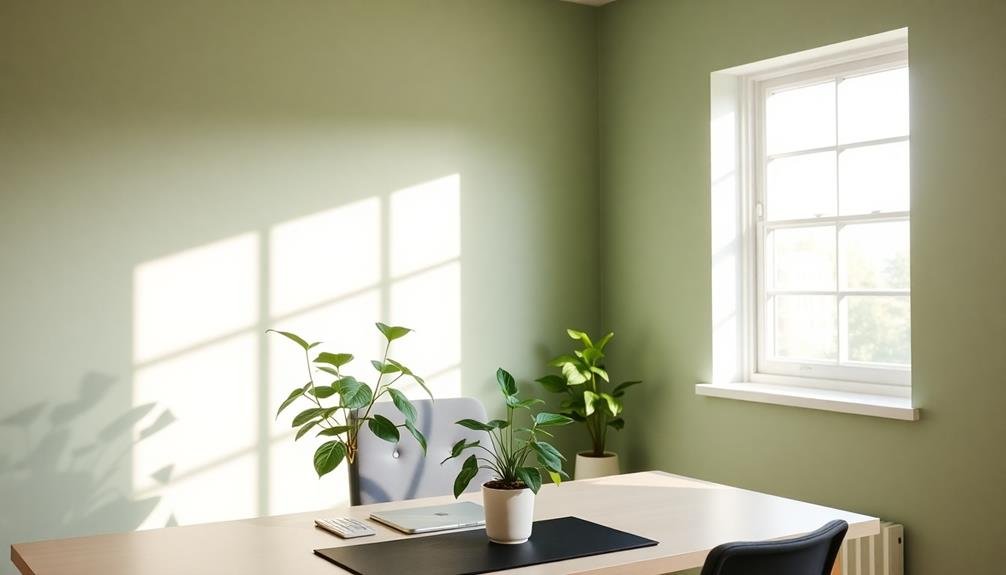
Beyond their environmental advantages, eco-friendly paints offer significant health benefits for you and your family. These paints contain fewer volatile organic compounds (VOCs), which are harmful chemicals that can cause respiratory issues, headaches, and other health problems. By choosing eco-friendly paints, you'll reduce your exposure to these toxins, creating a healthier home office environment.
Many eco-friendly paints are also formulated to resist mold and mildew growth, further improving indoor air quality. This is especially beneficial if you live in a humid climate or have allergies. Additionally, these paints often have low odor levels, allowing you to use your home office soon after painting without experiencing unpleasant smells or potential health effects.
| Health Benefit | Conventional Paint | Eco-Friendly Paint |
|---|---|---|
| VOC Levels | High | Low to Zero |
| Odor | Strong | Minimal |
| Mold Resistance | Limited | Enhanced |
| Allergy-Friendly | No | Yes |
Application and Maintenance Tips
Applying eco-friendly paints requires a few specific techniques to guarantee the best results. Before you begin, verify proper ventilation and wear protective gear.
Prepare the surface by cleaning and sanding it thoroughly. Most eco-friendly paints don't require a primer, but check the manufacturer's instructions. Apply thin, even coats using a high-quality brush or roller, allowing each layer to dry completely before adding the next.
For maintenance, regularly dust and clean painted surfaces with a soft, damp cloth. Avoid harsh chemicals or abrasive cleaners that might damage the paint or release toxins. Touch up any scratches or chips promptly to prevent further damage. If you need to remove stubborn stains, use a mild, eco-friendly cleaner.
To create a lasting impression in your home office, consider these eco-friendly paint application tips:
- Use long, smooth strokes for an even finish
- Start from the top and work your way down
- Paint in natural daylight for accurate color representation
- Allow proper drying time between coats
- Clean tools with water instead of solvents
Frequently Asked Questions
How Do Green Paints Affect Indoor Air Quality Long-Term?
Green paints can considerably improve your indoor air quality over time. They'll emit fewer volatile organic compounds (VOCs), reducing harmful fumes. You'll breathe easier and experience fewer health issues related to poor air quality in your home office.
Are Eco-Friendly Paints More Expensive Than Conventional Ones?
You'll often find eco-friendly paints cost more than conventional ones. However, they're becoming more affordable as demand increases. Don't forget to factor in long-term benefits like improved air quality and reduced environmental impact when comparing prices.
Can Green Paints Be Used on All Surfaces?
You can use green paints on most surfaces, but it's important to check the label. They're suitable for walls, ceilings, and woodwork. However, for metal or specialized surfaces, you might need specific eco-friendly primers or paints.
Do Eco-Friendly Paints Come in a Wide Range of Colors?
You'll be pleased to know that eco-friendly paints come in a vast array of colors. You're not limited in your choices. Many brands offer extensive palettes, so you can easily find the perfect shade for your space.
How Long Do Green Paints Typically Last Compared to Regular Paints?
You'll find that eco-friendly paints often last just as long as regular ones. They're durable and can maintain their color for years. With proper application and care, you won't notice a difference in longevity between green and conventional paints.
In Summary
You've now got the tools to make an eco-friendly choice for your home office paint. Remember, green paints aren't just better for the environment; they're healthier for you too. Whether you opt for low-VOC, natural, or recycled options, you're making a positive impact. Don't forget to take into account application and maintenance when making your decision. With these green paint choices, you'll create a workspace that's both stylish and sustainable.

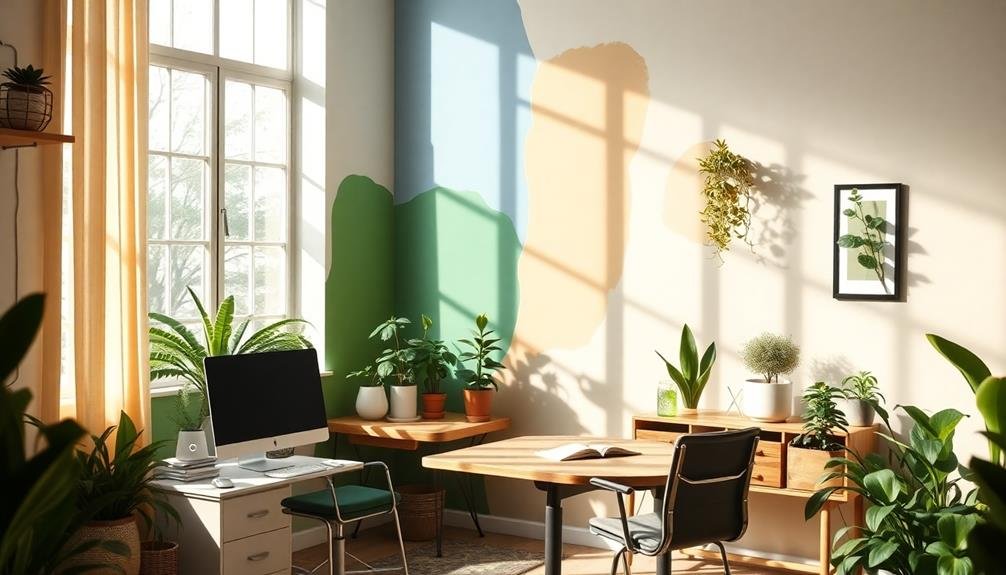
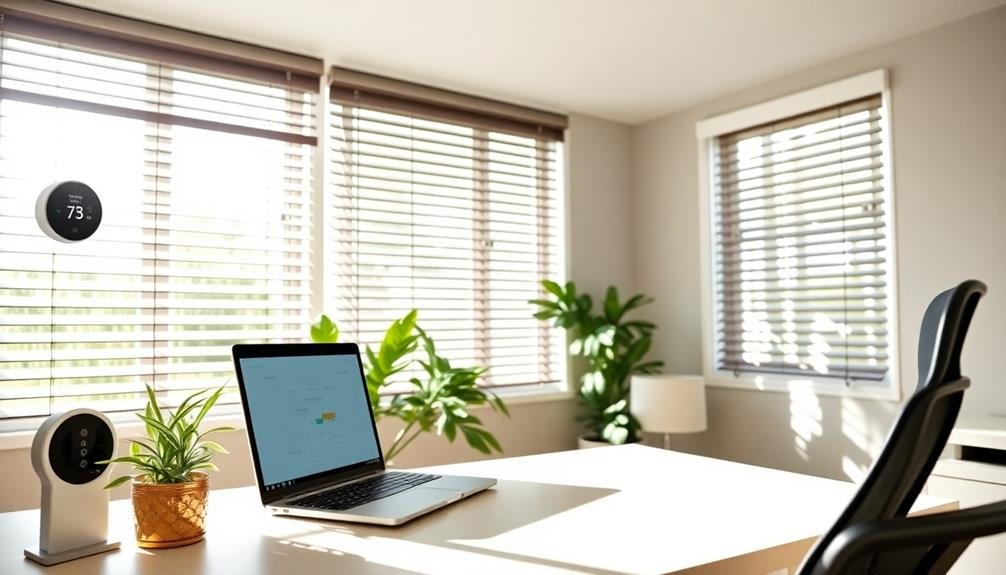
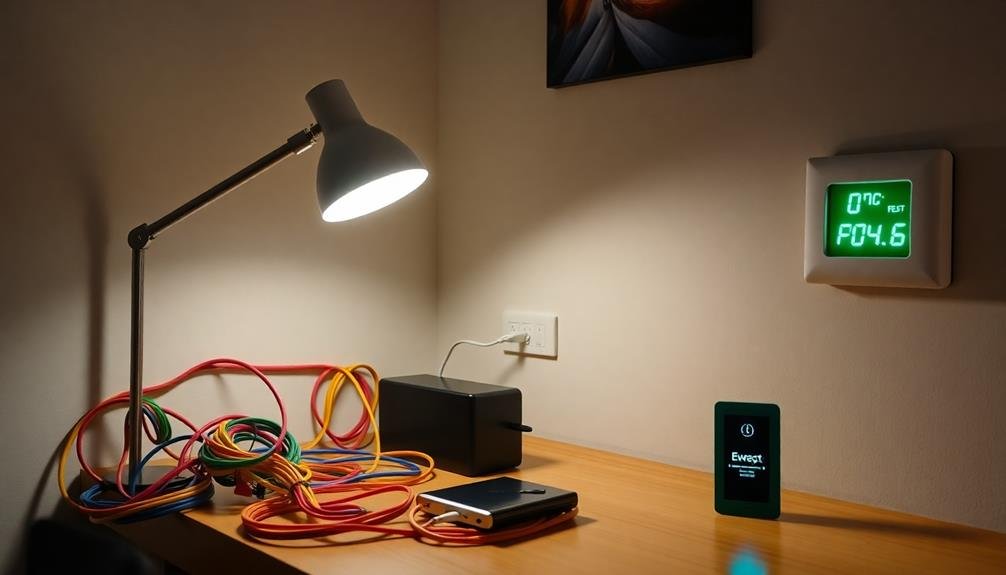

Leave a Reply